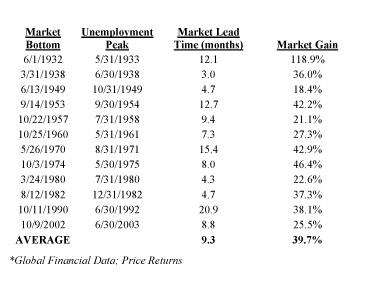Personal Wealth Management / Market Analysis
Employing Sound Judgment
Employment data contributed to wild swings in stock prices today.
Story Highlights:
- Another round of dreary employment news helped send the stock market on a wild ride today.
- Unemployment continues to rise, but so will stock prices before long.
- The stock market has historically always moved higher before unemployment peaks.
- Gloomy economic data, including increasing unemployment, will continue, but stocks will recover before economic news.
_________________________________________________________________________
Yet another bleak employment report contributed to wild market gyrations today. Before the market opened, the Labor Department announced employers cut a total of 651,000 jobs in February, in line with expectations. That brought the US unemployment rate to 8.1%, a 25 year high.
Investors cheered the seemingly gloomy news initially, bidding up US stocks by 2.4%. But as the day wore on, shares drifted lower. At its lowest point, the S&P 500 was down 2.3%, a 4.6% swing from peak-to-trough. Finally, a late-day surge brought the market back to just about even.
This type of volatility reflects the wild shifts in sentiment accompanying investor uncertainty surrounding various forces including the state of the global economy and the myriad governmental machinations. Today's employment data might seem alarming at first, but those thinking the stock market won't turn until the employment conditions improve are in for a surprise. Going back to the 1920s, the US market has always recovered before unemployment trends down, no exceptions. The table below shows market activity surrounding peaks in unemployment (note: some but not all of these dates coincide with bear market bottoms):
On average, the stock market recovery begins about nine months before unemployment peaks. But the market's lead time varies from just over three months (before the 1938 unemployment peak) to almost 21 months (before the 1992 peak). Regardless of the amount of time the stock market leads improving employment, it pays to be invested to catch the initial upswing in stock prices. The market has always moved substantially higher during these periods, gaining almost 40% on average between market bottoms and unemployment peaks.
Economic data, including unemployment, will continue to be weak both in the US and abroad for some time, but a market recovery is overwhelmingly likely to precede meaningful economic improvement. Not being invested during the initial market upswing is a risky prospect for long-term investors.
If you would like to contact the editors responsible for this article, please message MarketMinder directly.
*The content contained in this article represents only the opinions and viewpoints of the Fisher Investments editorial staff.
Get a weekly roundup of our market insights
Sign up for our weekly e-mail newsletter.

You Imagine Your Future. We Help You Get There.
Are you ready to start your journey to a better financial future?

Where Might the Market Go Next?
Confidently tackle the market’s ups and downs with independent research and analysis that tells you where we think stocks are headed—and why.






